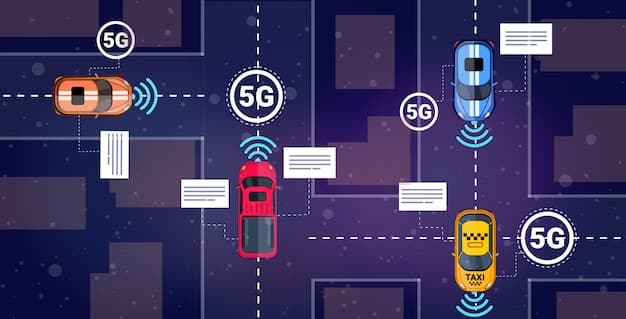Edge Computing’s Pivotal Role in US Autonomous Vehicle Development

Edge computing plays a crucial role in autonomous vehicle development in the US by enabling real-time data processing, reducing latency, and enhancing decision-making capabilities, which are essential for safety and efficiency.
The development of autonomous vehicles in the US is heavily reliant on advanced technologies, with edge computing playing a pivotal role. This technology brings computational power closer to the data source, which is essential for real-time processing and decision-making in self-driving cars.
Understanding the Basics of Edge Computing
Edge computing is a distributed computing paradigm that brings data processing and storage closer to the edge of the network, where data is generated. This proximity reduces latency and bandwidth usage, making it ideal for applications requiring real-time responses.
Key Components of Edge Computing
Edge computing infrastructures consist of various components, including edge devices, edge servers, and the cloud. Each plays a distinct role in processing and managing data.
- Edge Devices: These are the sensors and devices deployed in the field, collecting data from the environment. In autonomous vehicles, these include cameras, LiDAR, radar, and ultrasonic sensors.
- Edge Servers: These servers are located closer to the edge devices than the cloud, providing local processing and storage capabilities. They filter, analyze, and process data before sending it to the cloud, reducing the workload on the central servers.
- Cloud: The cloud provides additional storage and processing power for tasks that require more resources or broader analysis. It also serves as a central repository for data and models.
The synergy between these components ensures efficient, real-time data processing essential for autonomous vehicles to operate safely and effectively.
In summary, edge computing provides the necessary infrastructure for autonomous vehicles to make timely decisions and manage data efficiently. This involves a network of devices, servers, and cloud resources working together to process and analyze data in real-time.
The Significance of Low Latency in Autonomous Vehicles
Low latency is critical in autonomous vehicle development because it directly impacts the vehicle’s ability to react to its environment in a timely manner. Delays in processing data can lead to delayed responses, potentially causing accidents.
Why Latency Matters for Safety
Autonomous vehicles rely on a constant stream of data from sensors to make driving decisions. High latency can delay these decisions, compromising safety.
- Real-Time Reactions: Low latency enables vehicles to react instantly to changes, such as sudden braking by other vehicles or pedestrians crossing the street.
- Accident Avoidance: Fast data processing helps in avoiding collisions by enabling quick evasive maneuvers.
- Enhanced Reliability: Reducing latency improves the overall reliability of the autonomous system, making it more trustworthy.
The importance of low latency cannot be overstated. It is a fundamental requirement for ensuring the safety and reliability of autonomous vehicles on US roads.
In conclusion, low latency ensures the immediate reaction of autonomous vehicles to their surroundings, which is crucial for safety and reliability. By minimizing delays in data processing, edge computing enhances the overall performance of self-driving cars.
How Edge Computing Reduces Latency
Edge computing reduces latency by processing data closer to the source, minimizing the distance data needs to travel to be analyzed and acted upon. This localized processing significantly speeds up response times.

The Process of Latency Reduction
Edge computing achieves latency reduction through several mechanisms, including localized processing, data filtering, and optimized data transmission.
- Localized Processing: By processing data on-site, rather than sending it to a remote server, the time required for data transmission is significantly reduced.
- Data Filtering: Edge servers filter out irrelevant data, reducing the amount of data that needs to be processed and transmitted, further decreasing latency.
- Optimized Transmission: Edge computing optimizes data transmission by prioritizing critical data, minimizing delays and ensuring timely delivery of essential information.
These mechanisms collectively contribute to the significant reduction in latency that edge computing provides, making it an essential component for autonomous vehicle development in the US.
In summary, edge computing reduces latency by processing data closer to the source, filtering out irrelevant data, and optimizing data transmission. This enhances the ability of autonomous vehicles to respond quickly to their environment, improving safety and efficiency.
Edge Computing Architectures for Autonomous Vehicles
The architecture of edge computing systems for autonomous vehicles involves integrating various hardware and software components to ensure efficient data processing and real-time decision-making. Different architectures offer varying levels of performance and scalability.
Common Architectural Models
Several architectural models are commonly used in autonomous vehicle development, each designed to optimize specific aspects of data processing and vehicle performance.
- Hierarchical Architecture: This model involves multiple layers of processing, with edge devices collecting data, edge servers performing initial analysis, and the cloud handling more complex tasks.
- Distributed Architecture: In this model, processing tasks are distributed across multiple edge servers, providing redundancy and scalability.
- Hybrid Architecture: This combines elements of both hierarchical and distributed architectures, offering flexibility and adaptability to different operational needs.
The choice of architecture depends on the specific requirements of the autonomous vehicle and the environment in which it operates. Factors such as data volume, latency requirements, and security considerations influence the selection process.
In short, the architectures for edge computing in autonomous vehicles vary, but they all involve a combination of hardware and software components designed to optimize data processing and decision-making. The choice of architecture depends on the specific needs of the vehicle and its operational environment.
Challenges and Solutions in Implementing Edge Computing
Implementing edge computing in autonomous vehicles presents several challenges, including security concerns, interoperability issues, and the need for robust and reliable systems. Addressing these challenges requires innovative solutions and careful planning.

Overcoming Implementation Hurdles
Several strategies can be employed to overcome the challenges associated with implementing edge computing in autonomous vehicles, ensuring secure, reliable, and efficient operations.
- Security Measures: Implementing robust security measures such as encryption, authentication, and intrusion detection systems to protect data and infrastructure from cyber threats.
- Interoperability Standards: Adopting industry standards to ensure seamless communication and data exchange between different edge devices and systems.
- Reliability and Redundancy: Designing systems with redundancy and failover mechanisms to ensure continuous operation even in the event of component failures.
The successful implementation of edge computing requires a comprehensive approach that addresses these challenges and incorporates best practices in security, interoperability, and reliability.
In summary, addressing the challenges in implementing edge computing in autonomous vehicles involves robust security measures, adherence to interoperability standards, and the design of reliable and redundant systems. This ensures the safe and efficient operation of self-driving cars.
Future Trends in Edge Computing for Autonomous Vehicles
The future of edge computing in autonomous vehicles is poised for significant advancements, driven by innovations in hardware, software, and artificial intelligence. Emerging trends promise to further enhance the capabilities and performance of self-driving cars.
Emerging Technologies and Innovations
Several emerging technologies and innovations are expected to shape the future of edge computing in autonomous vehicles. These include AI-driven edge processing, 5G connectivity, and advanced sensor technologies.
- AI-Driven Edge Processing: Integrating artificial intelligence and machine learning algorithms into edge devices to enable more sophisticated data analysis and decision-making at the edge.
- 5G Connectivity: Leveraging the high bandwidth and low latency of 5G networks to enhance communication between autonomous vehicles and edge infrastructure.
- Advanced Sensors: Developing more accurate and reliable sensors that generate higher-quality data, improving the overall performance of autonomous systems.
These trends collectively point towards a future where autonomous vehicles are more intelligent, connected, and capable, thanks to the continued advancements in edge computing technology.
In conclusion, the future trends in edge computing for autonomous vehicles include AI-driven edge processing, 5G connectivity, and advanced sensor technologies. These innovations are expected to drive significant improvements in the capabilities and performance of self-driving cars.
| Key Concept | Brief Description |
|---|---|
| 🚗 Edge Computing | Processes data near the source, reducing latency. |
| ⏱️ Low Latency | Critical for real-time vehicle reactions. |
| 🛡️ Security | Protecting data and infrastructure from cyber threats. |
| 🌐 5G Connectivity | Enhances communication between vehicles and infrastructure. |
Frequently Asked Questions
▼
Edge computing processes data closer to the source, reducing latency. For autonomous vehicles, this means faster reaction times, enhancing safety by enabling quicker responses to real-time events on the road.
▼
Edge computing reduces latency by processing data locally within the vehicle or nearby edge servers instead of sending it to a distant cloud. This minimizes the time it takes for decisions to be made.
▼
Challenges include ensuring robust security to protect against cyber threats, maintaining interoperability between different systems, and ensuring system reliability through redundancy and failover mechanisms to protect the overall system.
▼
5G enhances edge computing by providing faster and more reliable communication between vehicles and edge infrastructure. Its high bandwidth and low latency are also key to improving the overall efficiency of autonomous systems.
▼
AI is integrated into edge computing to enable more sophisticated data analysis and decision-making at the edge. This allows vehicles to quickly adapt to changing conditions and make real-time decisions without relying on cloud-based processing.
Conclusion
In conclusion, edge computing plays a vital role in the development of autonomous vehicles in the US by enabling real-time data processing, reducing latency, and enhancing decision-making. Overcoming the challenges and embracing future trends in edge computing will pave the way for safer, more efficient, and more reliable self-driving cars on US roads.





